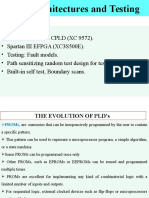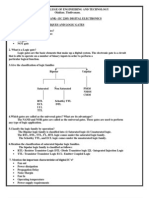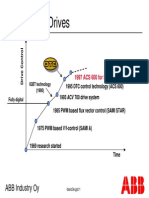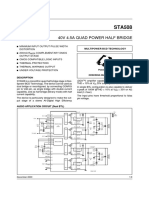Complex Programmable Logic Devices (CPLDS) : Programming
Complex Programmable Logic Devices (CPLDS) : Programming
Uploaded by
anshu4u06Copyright:
Available Formats
Complex Programmable Logic Devices (CPLDS) : Programming
Complex Programmable Logic Devices (CPLDS) : Programming
Uploaded by
anshu4u06Original Description:
Original Title
Copyright
Available Formats
Share this document
Did you find this document useful?
Is this content inappropriate?
Copyright:
Available Formats
Complex Programmable Logic Devices (CPLDS) : Programming
Complex Programmable Logic Devices (CPLDS) : Programming
Uploaded by
anshu4u06Copyright:
Available Formats
ansferred from the
cia1 programming
lgramming unit is
it; each adaptor is
Usually, the pro-
'ter programming,
ion of the process
: chips is given in
chips on a printed
p can be removed
.I is made possible
,As and PALs are
2ilable in another
~i ch is depicted in
wrap around" the
I DIP. The socket
,CC is held in the
E
be advantageous
ircuit board. This 1
usually provided
described below.
I I
r
i
i
f
;
;
i
Figure 3.31 A PLCC package with socket.
3.6.4 COMPLEX PROGRAMMABLE LOGIC DEVICES (CPLDs)
PLAs and PALs are useful for implementing a wide variety of small digital circuits. Each
device can be used to implement circuits that do not require more than the number of inputs,
product terms, and outputs that are provided in the particular chip. These chips are limited
to fairly modest sizes, typically supporting a combined number of inputs plus outputs of not
more than 32. For implementation of circuits that require more inputs and outputs, either
multiple PLAs or PALs can be employed or else a more sophisticated type of chip, called
a complex programmable logic device (CPLD), can be used.
A CPLD comprises multiple circuit blocks on a single chip, with internal wiring re-
sources to connect the circuit blocks. Each circuit block is similar to a PLA or a PAL; we
will refer to the circuit blocks as PAL-like blocks. An example of a CPLD is given in Figure
3.32. It includes four PAL-like blocks that are connected to a set of interconnection wires.
Each PAL-like block is also connected to a subcircuit labeled I/O block, which is attached
to a number of the chip's input and output pins.
Figure 3.33 shows an example of the wiring structure and the connections to a PAL-like
block in a CPLD. The PAL-like block includes 3 macrocells (real CPLDs typically have
about 16 macrocells in a PAL-like block), each consisting of a four-input OR gate (real
CPLDs usually provide between 5 and 20 inputs to each OR gate). The OR-gate output
is connected to another type of logic gate that we have not yet introduced. It is called an
Exclusive-OR (XOR) gate. We discuss XOR gates in section 3.9.1. The behavior of an
XOR gate is the same as for an OR gate except that if both of the inputs are 1, the XOR gate
t t
Interconnection wires
Figure 3.32 Structure of a complex programmable logic device (CPLD).
I
produces a 0. One input to the XOR gate in Figure 3.33 can be programmably connected
to 1 or 0; if 1, then the XOR gate complements the OR-gate output, and if 0, then the XOR
output value produced by the OR gate. Each tri-state buffer (see section 3.8.8) is connected
to a pin on the CPLD package. The tri-state buffer acts as a switch that allows each pin to
be used either as an output from the CPLD or as an input. To use a pin as an output, the
corresponding tri-state buffer is enabled, acting as a switch that is turned on. If the pin is
to be used as an input, then the tri-state buffer is disabled, acting as a switch that is turned
off. In this case an external source can drive a signal onto the pin, which can be connected
to other macrocells using the interconnection wiring.
The interconnection wiring contains programmable switches that are used to connect
the PAL-like blocks. Each of the horizontal wires can be connected to some of the vertical
wires that it crosses, but not to all of them. Extensive research has -been done to decide
how many switches should be provided for connections between the wires. The number
of switches is chosen to provide sufficient flexibility for typical circuits without wasting
many switches in practice. One detail to note is that when a pin is used as an input, the
macrocell associated with that pin cannot be used and is therefore wasted. Some CPLDs
include additional connections between the macrocells and the interconnection wiring that
avoids wasting macrocells in such situations.
Commercial CPLDs range in size from only 2 PAL-like blocks to more than 100 PAL-
like blocks. They are available in a variety of packages, including the PLCC package that
is shown in Figure 3.31. Figure 3. 34~ shows another type of package used to house CPLD
chips, called a quadJlatpack (QFP). Like a PLCC package, the QFPpackage has pins on all
You might also like
- Design of Arithmetic Calculator Using FpgaDocument58 pagesDesign of Arithmetic Calculator Using FpgavikramNo ratings yet
- EI2353 DSDQbankDocument24 pagesEI2353 DSDQbankRaja RockNo ratings yet
- Questions On Logic SynthesisDocument11 pagesQuestions On Logic SynthesisrAM89% (9)
- DE Unit 3Document11 pagesDE Unit 3BOMMA SRI MUKHINo ratings yet
- Deld End Sem 5,6Document6 pagesDeld End Sem 5,6The GK TalksNo ratings yet
- Pal PlaDocument12 pagesPal PlaRavi Ranjan100% (1)
- Programmable Logic DevicesDocument40 pagesProgrammable Logic DevicesjaigodaraNo ratings yet
- PLDDocument81 pagesPLDAntonio SabaNo ratings yet
- 4.1 Programmable Arrays of Logic GatesDocument10 pages4.1 Programmable Arrays of Logic Gatesjeddo2005No ratings yet
- Report Logic2Document12 pagesReport Logic2زياد عبدالله عبدالحميدNo ratings yet
- Programmable Logic Devices (PLDS) : Lesson ObjectivesDocument10 pagesProgrammable Logic Devices (PLDS) : Lesson ObjectivesjamaalnasirNo ratings yet
- CPLDDocument29 pagesCPLDajayg_lmgNo ratings yet
- Ref Lock 01Document5 pagesRef Lock 01Luis CupidoNo ratings yet
- Lecture 6 SlidesDocument27 pagesLecture 6 SlidesDiptanshu MalviyaNo ratings yet
- Programmable Logic DevicesDocument40 pagesProgrammable Logic DevicesNishanth NissanNo ratings yet
- Ec1203 Digital ElectronicsDocument20 pagesEc1203 Digital ElectronicsSiva Prasad PadilamNo ratings yet
- Two Mark Questions For DSDDocument17 pagesTwo Mark Questions For DSDvnirmalacseNo ratings yet
- PC/CP220 Digital Electronics Lab: Other CPLD BoardsDocument7 pagesPC/CP220 Digital Electronics Lab: Other CPLD BoardsCONG TRAN NGOCNo ratings yet
- Assignment - Muhammad Ali Asad - 014Document39 pagesAssignment - Muhammad Ali Asad - 014mumtazNo ratings yet
- 4.7 Programmable Logic Devices: "Programmed"Document6 pages4.7 Programmable Logic Devices: "Programmed"nitesh.mudgalNo ratings yet
- Pal UnitDocument11 pagesPal UnitMohamed HarbNo ratings yet
- Pal Unit PDFDocument11 pagesPal Unit PDFMohamed HarbNo ratings yet
- UNIT-VDocument75 pagesUNIT-Vananyakarra2005No ratings yet
- Lec 12 - Chap 10-PLDsDocument22 pagesLec 12 - Chap 10-PLDsAliRazaNo ratings yet
- 21bce2845 VL2022230104423 Da02Document7 pages21bce2845 VL2022230104423 Da02Sidharth GhaiNo ratings yet
- DE Module 05Document10 pagesDE Module 05Rishabh TiwariNo ratings yet
- PLDTUTORDocument13 pagesPLDTUTORAjay Nath S ANo ratings yet
- PLDsDocument39 pagesPLDsSANDEEP KUMARNo ratings yet
- Programmable Logic DevicesDocument29 pagesProgrammable Logic DevicesChethana HsNo ratings yet
- Scroll Pad: Submitted By: Raman Bedi Amit Sharma Ashish Dhiman Arvind ChauhanDocument48 pagesScroll Pad: Submitted By: Raman Bedi Amit Sharma Ashish Dhiman Arvind Chauhan2gud2beNo ratings yet
- 9.unit IX Programming DevicesDocument25 pages9.unit IX Programming DevicesPrashant SarrafNo ratings yet
- Advantages of PALDocument10 pagesAdvantages of PALvarun2chadha100% (1)
- Experiment 1 Basic Logic Gates: ObjectivesDocument10 pagesExperiment 1 Basic Logic Gates: Objectivesasdf lkjNo ratings yet
- Or Gate - WikipediaDocument6 pagesOr Gate - WikipediaDK vlogNo ratings yet
- Logic GatesDocument11 pagesLogic GatesAsyraf NorahairuzanNo ratings yet
- Au Co Lab Dated 15.09.2023Document51 pagesAu Co Lab Dated 15.09.2023cheboluyasaswiniNo ratings yet
- Appendices A. Microcontroller A.1 Description of 8051 The AT89S51 Is A Low-Power, High-Performance CMOS 8-BitDocument28 pagesAppendices A. Microcontroller A.1 Description of 8051 The AT89S51 Is A Low-Power, High-Performance CMOS 8-BitChinna ThambiNo ratings yet
- Low Power UART Design For Serial Data CommunicationDocument21 pagesLow Power UART Design For Serial Data CommunicationSuman Gm100% (1)
- FPGA Interview QuestionsDocument11 pagesFPGA Interview Questionssneha587No ratings yet
- Basic Digital Circuits: 1 Logic Gates and CircuitsDocument18 pagesBasic Digital Circuits: 1 Logic Gates and CircuitsssfofoNo ratings yet
- PLA Minimization and TestingDocument19 pagesPLA Minimization and TestingVardhan Roy100% (1)
- ECE 1315 Digital Logic Design Laboratory Manual: Guide To Assembling Your CircuitsDocument13 pagesECE 1315 Digital Logic Design Laboratory Manual: Guide To Assembling Your CircuitsMechatronics RECNo ratings yet
- Fpga Interview QuestionsDocument9 pagesFpga Interview QuestionsV SharmaNo ratings yet
- Abstract:: Figure 1: Basic FPGA ConfigurationDocument4 pagesAbstract:: Figure 1: Basic FPGA ConfigurationEr Nayan PithadiyaNo ratings yet
- PLD Architectures and TestingDocument37 pagesPLD Architectures and TestingParesh SawantNo ratings yet
- Unit 7Document54 pagesUnit 7Pavankumar GorpuniNo ratings yet
- Programmable Array Logic VHDL EnotesDocument15 pagesProgrammable Array Logic VHDL Enotesshrikant_talawarNo ratings yet
- Logic Gate: From Wikipedia, The Free EncyclopediaDocument10 pagesLogic Gate: From Wikipedia, The Free EncyclopediaHazim SanusiNo ratings yet
- Intelligent Water Control System Using 8051 (AT89C51) : Project ReportDocument12 pagesIntelligent Water Control System Using 8051 (AT89C51) : Project ReportNadeem AnjumNo ratings yet
- Digital Electronics Question BankDocument34 pagesDigital Electronics Question Banksujithaa13100% (1)
- DLD Assignment PDFDocument3 pagesDLD Assignment PDFMuhammad AliNo ratings yet
- WAN TECHNOLOGY FRAME-RELAY: An Expert's Handbook of Navigating Frame Relay NetworksFrom EverandWAN TECHNOLOGY FRAME-RELAY: An Expert's Handbook of Navigating Frame Relay NetworksNo ratings yet
- Build Logic Gates with Universal NAND: CMOS and TTL in ActionFrom EverandBuild Logic Gates with Universal NAND: CMOS and TTL in ActionNo ratings yet
- Practical Reverse Engineering: x86, x64, ARM, Windows Kernel, Reversing Tools, and ObfuscationFrom EverandPractical Reverse Engineering: x86, x64, ARM, Windows Kernel, Reversing Tools, and ObfuscationNo ratings yet
- Process Control Unit 1Document44 pagesProcess Control Unit 1anshu4u06No ratings yet
- GCSE Geography Instant RevisionDocument131 pagesGCSE Geography Instant RevisionCasey Rodriguez100% (14)
- 02 - 02 Basics of AC Drives Part 2Document16 pages02 - 02 Basics of AC Drives Part 2anshu4u06100% (1)
- Pune - University - Vlsi Book - Study - Plan XeroxDocument4 pagesPune - University - Vlsi Book - Study - Plan Xeroxanshu4u06No ratings yet
- 02 - 01 Basics of AC Drives Part 1Document6 pages02 - 01 Basics of AC Drives Part 1anshu4u06100% (1)
- MicrocontrollersDocument14 pagesMicrocontrollersanshu4u06100% (1)
- Op Amp Application - Electroniclect-11Document1 pageOp Amp Application - Electroniclect-11anshu4u06No ratings yet
- Computer NetworkingDocument150 pagesComputer Networkinganshu4u06No ratings yet
- Yoga For EyesDocument5 pagesYoga For Eyesanshu4u06No ratings yet
- Mc68332acfc16 20Document88 pagesMc68332acfc16 20Alex AlveraNo ratings yet
- DatasheetDocument8 pagesDatasheetStuxnetNo ratings yet
- Emd4e001gas2 1.3 10102022Document174 pagesEmd4e001gas2 1.3 10102022MagnusNo ratings yet
- LGLite ATE I2C LoadBoardDocument10 pagesLGLite ATE I2C LoadBoardVijayakumar SNo ratings yet
- SP 3232E - Transceptor RS232Document24 pagesSP 3232E - Transceptor RS232Tiago LeonhardtNo ratings yet
- MC33887Document40 pagesMC33887Muhammad Januar SusantoNo ratings yet
- ES9038Q2M Datasheet v1.4Document65 pagesES9038Q2M Datasheet v1.4Thắng NguyễnNo ratings yet
- MCU IO Expander IntelDocument11 pagesMCU IO Expander IntelPrabakaran EllaiyappanNo ratings yet
- 40V 4.5A Quad Power Half Bridge: Multipower BCD TechnologyDocument9 pages40V 4.5A Quad Power Half Bridge: Multipower BCD TechnologyDelcu MarinicaNo ratings yet
- L4 - CSE332.7 - SPRING - February 09, 2023 - MUUDocument9 pagesL4 - CSE332.7 - SPRING - February 09, 2023 - MUUTanzim Rafat 2013485642No ratings yet
- 8086 Hardware SpecificationDocument84 pages8086 Hardware SpecificationVikram Santhosh100% (1)
- Experiment #3 High Level Programming and System Memory ExpansionDocument17 pagesExperiment #3 High Level Programming and System Memory ExpansionErgin ÖzdikicioğluNo ratings yet
- Unit 5-2Document41 pagesUnit 5-2chris rubishaNo ratings yet
- Hand Gesture Control Wheel ChairDocument67 pagesHand Gesture Control Wheel ChairJoshep KennadiNo ratings yet
- Chapter Five Register Transfer and Microoperations: Computer ArchitectureDocument22 pagesChapter Five Register Transfer and Microoperations: Computer ArchitectureGafeer FableNo ratings yet
- Flashpak Datasheet 28F010Document30 pagesFlashpak Datasheet 28F010Will ?No ratings yet
- LVT-to-LVTH Conversion: SCEA010 January 1999Document12 pagesLVT-to-LVTH Conversion: SCEA010 January 1999flo72afNo ratings yet
- Guide To FPGADocument472 pagesGuide To FPGADavid CamarenaNo ratings yet
- Easypic v7 Manual v104Document38 pagesEasypic v7 Manual v104Rodolfo Víctor Hilario Poma100% (1)
- EE 109 Unit 18 - Noise Margins, Interfacing, and Tri-StatesDocument22 pagesEE 109 Unit 18 - Noise Margins, Interfacing, and Tri-StatesEmin KültürelNo ratings yet
- Chapter 9: 8086/8088 Hardware SpecificationsDocument28 pagesChapter 9: 8086/8088 Hardware SpecificationsChanchan LebumfacilNo ratings yet
- DS FT2232HDocument67 pagesDS FT2232HEmiliano KleinNo ratings yet
- Lec05 Introduction To Macros and SRAM LintDocument48 pagesLec05 Introduction To Macros and SRAM Lintyanjia8161100No ratings yet
- ATmega8, L PDFDocument23 pagesATmega8, L PDFVlad VladosNo ratings yet
- 8-Bit Microcontroller With 16K Bytes In-System Programmable Flash Atmega169V Atmega169Document26 pages8-Bit Microcontroller With 16K Bytes In-System Programmable Flash Atmega169V Atmega169Helal ShamesNo ratings yet
- Tips To Optimize Your Verilog HDL CodeDocument9 pagesTips To Optimize Your Verilog HDL CodeZaheer AbbasNo ratings yet
- Coa 1ST LessonDocument17 pagesCoa 1ST LessonMukeshNo ratings yet
- EE1A2: Microprocessor Systems & Digital Logic: DR S. I. Woolley Electronic, Electrical and Computer EngineeringDocument50 pagesEE1A2: Microprocessor Systems & Digital Logic: DR S. I. Woolley Electronic, Electrical and Computer Engineeringrak12345No ratings yet
- 8-Bit Microcontroller With 16K Bytes In-System Programmable Flash Atmega16 Atmega16LDocument50 pages8-Bit Microcontroller With 16K Bytes In-System Programmable Flash Atmega16 Atmega16LKamal Singh RathoreNo ratings yet
- TMS320F206 Digital Signal ProcessorDocument57 pagesTMS320F206 Digital Signal ProcessorMiguel Ángel CoriaNo ratings yet


































































































